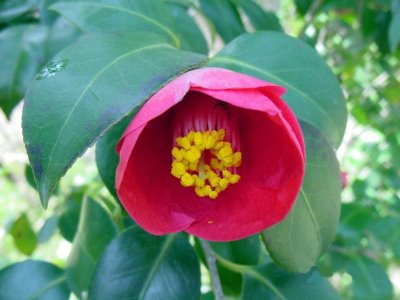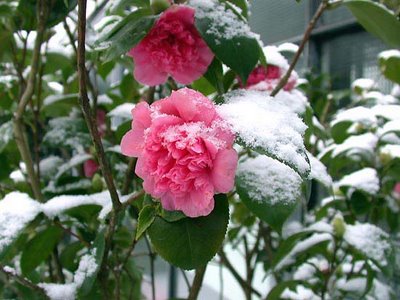Camellia japonica

Common Names: camellia, japonicas
Family: Theaceae (tea family)
The Camellia produces flowers up to 5 in (12.7 cm) wide with yellow centers and rounded overlapping petals, much like a rose. The flowers are prized, but so are the glossy leaves that stay a deep, shiny green all year. It is a slow grower, but eventually will reach up to 20 ft (6.1 m) tall. Camellias flower from late winter to early spring. Over 3,000 varieties, cultivars and hybrids of Camellia japonica are cultivated.

A native of China, camellias are a traditional favorite across the southeastern U.S. Throughout the winter, camellias brighten the landscape, from sandy migrant workers' camps to white-columned plantation homes.
Camellias like acid soil with plenty of moisture. Since early morning sun may cause petals to become limp and brown, an ideal location would be west of a structure or barrier wall. Prune in spring after flowering. Keep other plants a safe distance away and apply mulch to protect the camellia's shallow roots.
Growing Tips
These make fine garden plants in sheltered areas if the soil in which they are growing is acid rather than alkaline.
Perhaps not so good for the indoor location, they are nevertheless excellent plants for porches and conservatiories that offer a little shelter from the elements. Plants that are grown from seed sown in the spring, or from cduttings rooted in the autumn, can be purchased in small pots from good retailers.
With careful handling these samll plantgs can be gradually potted on until they are in containers of 25cm in diameter - use the acid soil recommended for camellias at each potting stage, and collect rain water for watering.
In time plants of about 150cm in height will have developed, and in early spring there can surely be nothigun more appealing than camellia blooms in white, pink or red.
Light: Prefers partial shade, but they need more sun in colder climates.
Moisture: Prefers rich moist soil, but is adaptable.
Hardiness: USDA Zones 6-9. Camellias are hardy, but for extra protection, apply mulch and cover flower buds if frost threatens.
Propagation: Take semi-ripe cuttings from late summer to winter (use rooting hormone). Can also be air-layered in spring.
To encourage bloom: Maintain cool condition.
UsageThis very popular shrub is used in borders and in formation hedges. Use it for specimen plants on the lawn and for colorful accents near outdoor living areas. Camellias are especially attractive and easy to grow when planted under a canopy of live oaks and pine trees that provide broken shade. It is tolerant of urban conditions if maintained, and can also be used in containers.

Symbolism
The genus was named for George Kamel, a Jesuit missionary who travelled in Asia and studied the flora of the Philippines. Red camellias symbolize intrinsic worth and white blossoms mean loveliness. Displayed at Korean weddings as far back as 1200 BC, camellias represent longevity and faithfulness.









0 Comments:
Post a Comment
<< Home